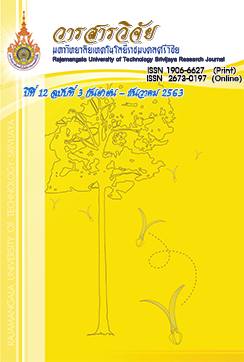การพัฒนาระบบสารสนเทศเพื่อการจัดการขยะสำหรับศูนย์เรียนรู้ การจัดการขยะแบบครบวงจร
คำสำคัญ:
ระบบสารสนเทศเพื่อการจัดการ, ศูนย์เรียนรู้การจัดการขยะแบบครบวงจร, การจัดการขยะบทคัดย่อ
ปริมาณขยะที่เพิ่มมากขึ้นในทุกวันส่งผลกระทบต่อธรรมชาติก่อให้เกิดก๊าซคาร์บอนไดออกไซด์ที่เป็นต้นเหตุที่ทำให้เกิดภาวะเรือนกระจก จากปัญหาดังกล่าวจึงได้ศึกษาและจัดทำงานวิจัยนี้ขึ้นโดยมีวัตถุประสงค์เพื่อ 1) ศึกษารูปแบบการจัดการขยะในศูนย์เรียนรู้การจัดการขยะแบบครบวงจร 2) ออกแบบและพัฒนาระบบสารสนเทศเพื่อการจัดการขยะในศูนย์เรียนรู้การจัดการขยะแบบครบวงจร และ 3) ประเมินความพึงพอใจของผู้ใช้งานระบบ กลุ่มตัวอย่างที่ใช้ในการวิจัยในครั้งนี้ ได้แก่ อาจารย์จำนวน 15 คน และนักเรียนจำนวน 30 คน ของโรงเรียนสังกัดเขตกรุงเทพมหานครทั้งหมด 6 โรงเรียน โดยใช้วิธีการสุ่มตัวอย่างแบบเฉพาะเจาะจง เครื่องมือที่ใช้ในการวิจัยประกอบด้วย 1) ระบบสารสนเทศเพื่อการจัดการข้อมูลขยะในศูนย์เรียนรู้การจัดการขยะแบบครบวงจร เป็นโปรแกรมประยุกต์บนเดกส์ท็อปพัฒนาโดยใช้หลักการเชิงวัตถุ ภาษาคอมพิวเตอร์ที่ใช้ในการพัฒนาคือ ไมโครซอฟท์วิชวลเบสิก และฐานข้อมูลคือ ไมโครซอฟท์แอคเซส 2) แบบประเมินความพึงพอใจของผู้ใช้ระบบ สถิติที่ใช้ในการวิเคราะห์ข้อมูล ได้แก่ ค่าเฉลี่ย และค่าเบี่ยงเบนมาตรฐาน ผลการวิจัยพบว่า 1) ผลการศึกษารูปแบบการจัดการขยะโดยวิธีการคัดแยกขยะเป็นการสร้างจิตสำนึกที่ดีในการอนุรักษ์สิ่งแวดล้อมและการจัดการขยะของนักเรียนในโรงเรียนสังกัดกรุงเทพมหานคร 2) ผลการประเมินความพึงพอใจของผู้ใช้ระบบ ภาพรวมอยู่ในระดับมากที่สุด ( = 4.59, S.D. = 0.70)
เอกสารอ้างอิง
กรมควบคุมมลพิษ. 2554. คู่มือการจัดการขยะมูลฝอยและเทคโนโลยีการแปรรูปขยะมูลฝอยให้เป็นพลังงานสำหรับท้องถิ่น. สำนักงานสิ่งแวดล้อมภาคที่ 15 (ภูเก็ต). แหล่งที่มา: https://www.reo15.go.th/news_document/detail/91/data.html, 22 มีนาคม 2561.
ดาวรถา วีระพันธ์. 2561. ระบบสารสนเทศจัดการสุขภาพของบุคลากรและนักศึกษาด้วยเทคโนโลยีบาร์โค้ด. วารสารวิจัยและพัฒนา วไลยอลงกรณ์ ในพระบรมราชูปถัมภ์ 13(2): 126-136.
ธนกฤต บวกขุนทด. 2553. การศึกษารูปแบบการจัดการการจัดเก็บขยะชุมชน กรณีศึกษา: องค์การบริหารส่วนตำบลโนนเมืองพัฒนา อำเภอด่านขุนทด จังหวัดนครราชสีมา. วิทยานิพนธ์ปริญญาวิศวกรรมศาสตรมหาบัณฑิต, มหาวิทยาลัยเทคโนโลยีสุรนารี.
ธเรศ ศรีสถิตย์. 2549. รายงานการวิจัย อัตราการเกิดและองค์ประกอบของมูลฝอยของกรุงเทพมหานคร. ภาควิชาวิศวกรรมสิ่งแวดล้อม คณะวิศวกรรมศาสตร์ จุฬาลงกรณ์มหาวิทยาลัย, กรุงเทพฯ.
ธีรชัย ศิริเมธากุล. 2556. MSIT แอปพลิเคชันบนอุปกรณ์เคลื่อนที่. วิทยานิพนธ์ปริญญาวิทยาศาสตรมหาบัณฑิต,มหาวิทยาลัยเทคโนโลยีมหานคร.
น้ำฝน อัศวเมฆิน. 2558. หลักการพื้นฐานของวิศวกรรมซอฟต์แวร์. วี.พริ้นท์ 1991 จำกัด, กรุงเทพฯ.
ปิยชาติ ศิลปสุวรรณ. 2557. ขยะมูลฝอยชุมชน ปัญหาใหญ่ที่ประเทศกำลังเผชิญ. สถาบันทรัพยากรธรรมชาติและสิ่งแวดล้อม. แหล่งที่มา: http://nrei.rmutsv.ac.th/sites/
default/files/poprosal/บทความวิชาการขยะมูลฝอยชุมชนปัญหาใหญ่ที่ประเทศกำลังเผชิญ.PDF, 22 มีนาคม 2561.
วิภาณี อุชุปัจ. 2561. ความรู้ พฤติกรรมในการจัดการขยะของประชาชน และคุณภาพการบริการในการจัดการขยะขององค์การบริหารส่วนตำบลเหล่ายาว อำเภอบ้านโฮ่ง จังหวัดลำพูน. วิทยานิพนธ์ปริญญาสาธารณสุขศาสตรมหาบัณฑิต, มหาวิทยาลัยราชภัฏเชียงใหม่.
สำนักสิ่งแวดล้อม กรุงเทพมหานคร. 2551. รายงานสถานการณ์สิ่งแวดล้อม 2549-2550. พิมพ์ครั้งที่ 1. ห้างหุ้นส่วนจำกัด โรงพิมพ์อักษรไทย (น.ส.พ. ฟ้าเมืองไทย), กรุงเทพฯ.
Gunawan, E.S. 2017. The Need of Rhetorical Design on Global Brands’Websites, pp. 1-6. In 2017 International Conference on Computing, Engineering, and Design (ICCED). International Islamic University, Malaysia.
Labib, S.M. 2017. Volunteer GIS (VGIS) based waste management: A conceptual design and use of web 2.0 for smart waste management in Dhaka City, pp. 137-141. In 2017 Third International Conference on Research in Computational Intelligence and Communication Networks (ICRCICN). University of Manchester, United Kingdom.
ดาวน์โหลด
เผยแพร่แล้ว
รูปแบบการอ้างอิง
ฉบับ
ประเภทบทความ
สัญญาอนุญาต
เนื้อหาและข้อมูลในบทความที่ลงตีพิมพ์ในวารสารวิจัยมหาวิทยาลัยเทคโนโลยีราชมงคลศรีวิชัย ถือเป็นข้อคิดเห็นและความรับผิดชอบของผู้เขียนบทความโดยตรง ซึ่งกองบรรณาธิการวารสารไม่จำเป็น ต้องเห็นด้วย หรือร่วมรับผิดชอบใดๆ
บทความ ข้อมูล เนื้อหา รูปภาพฯลฯ ที่ได้รับการตีพิมพ์ในวารสารวิจัย มหาวิทยาลัยเทคโนโลยีราชมงคลศรีวิชัย ถือเป็นลิขสิทธ์ของวารสารวิจัย มหาวิทยาลัยเทคโนโลยีราชมงคลศรีวิชัย หากบุคคลหรือหน่วยงานใดต้องการนำทั้งหมดหรือส่วนหนึ่งส่วนใดไปเผยแพร่ต่อหรือเพื่อการกระทำการใดๆจะต้องได้รับอนุญาตเป็นลายลักษ์อักษรจากวารสาร มหาวิทยาลัยเทคโนโลยีราชมงคลศรีวิชัยก่อนเท่านั้น







